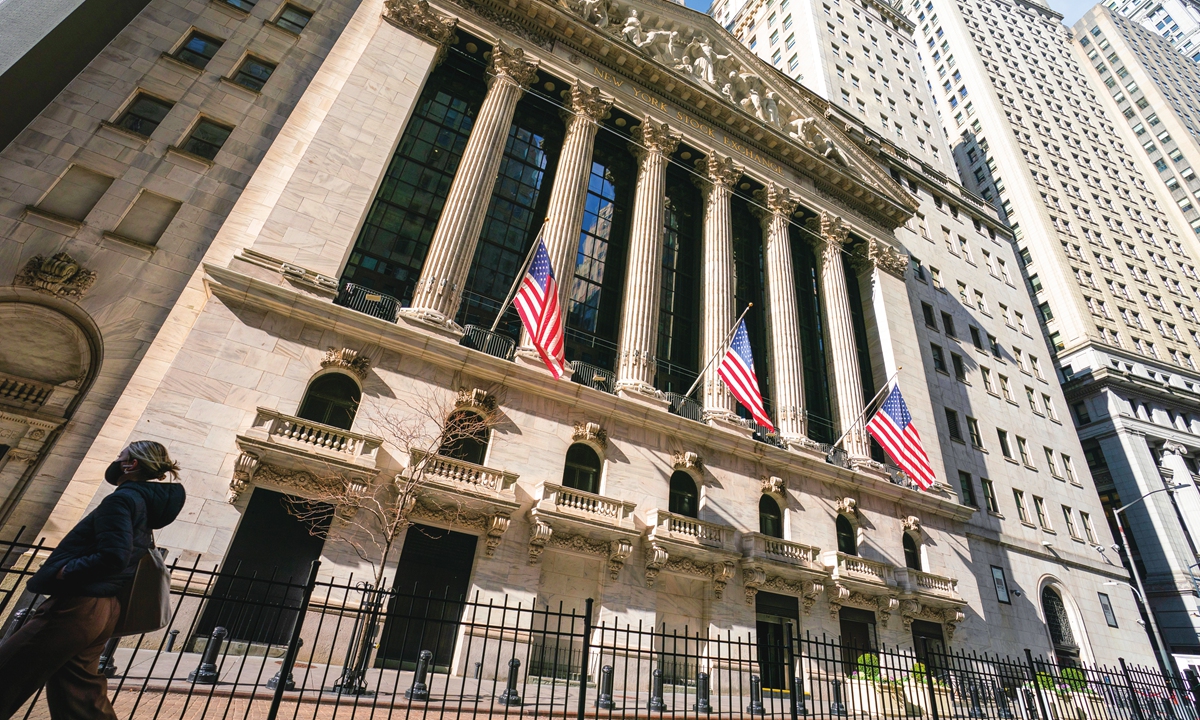
A pedestrian passes the New York Stock Exchange on January 24, 2022. Photo: VCG
US bank stocks mostly fell on Thursday, after crypto bank Silvergate announced it would close and Silicon Valley Bank (SVB) suffered a liquidity crisis, sparking panic in the market. The four largest US banks lost $46.5 billion in market value in Thursday trading.
Shares of SVB fell more than 20 percent in premarket trading on Friday, after the bank's shares collapsed 60 percent on Thursday, the biggest drop on record. Silvergate fell more than 42 percent to an all-time low on Thursday. The Philadelphia Bank Index plunged 7.7 percent, its worst daily performance since June 2020.
Analysts said that US banks are now paying for the country's rate hikes, which have led to poorer liquidity. This will also have an impact on the credibility of dollar assets, they said, and there is the possibility of wider effects in the global market.
As the panic continued to spread, several venture-capital firms, including Coatue, USV, and Founders Fund, advised companies to pull money out of SVB, according to media reports.
SVB Financial Group, the parent company of SVB, on Wednesday announced a $2.25 billion stock sale and a $500 million fundraising round, read the financial report released by SVB on Wednesday.
At the same time, SVB was forced into a fire sale of its securities, selling $21 billion worth of its holdings at a loss of $1.8 billion.
The move aimed to shore up its balance sheet as it grapples with declining deposits from technology start-ups, according to the Financial Times.
Statistics from PitchBook showed that the venture-capital deal volume fell more than 30 percent to $238 billion in 2022.
According to the bank's website, nearly half of US venture-backed technology and life science companies bank with SVB and 44 percent of US venture-backed technology and healthcare IPOs in 2022 bank with SVB.
The root cause of the turbulence in the banking sector is that the US raised interest rates in an unprecedented manner in 2022. It can be said that 2022 was a watershed year for the entire financial and investment environment in the US, Chen Da, managing director at HH Asia, told the Global Times on Friday.
"The US interest rate hike was aimed at reducing inflation from 6 percent to its target of 2 percent, which is bound to lead to some reaction in the financial markets. As one of the results, the liquidity of US commercial banks has become worse. They are paying for the interest rate rise," said Chen.
The inflation rate in the US in January was still much higher than expected, with an increase of 0.5 percent month-on-month and 6.4 percent year-on-year.
Stubbornly high inflation means that the US Federal Reserve's previous moves to raise interest rates have been fruitless, Pan Helin, co-director of the Research Center for Digital Economics and Financial Innovation at Zhejiang University, told the Global Times on Friday.
But Pan said that the Fed is likely to raise interest rates again by 50 basis points, if inflation continues to rise month-on-month.
"It is well known that the Fed's decision to raise interest rates is currently only based on inflation. Fed Chairman Jerome Powell is eager to achieve quick success in raising interest rates," said Pan.
Wall Street banks expect the Fed to raise rates by 50 basis points to 5-5.25 percent in March, with the eventual target of more than 6 percent in the future, according to media reports.
One of the results of the rate hikes is a dollar squeeze, which has caused the value of non-dollar assets around the world to fall. Since the dollar accounts for a high proportion of global liquidity and reserves, most risky assets are not immune, Pan noted.
Analysts also pointed out that there will be a subsequent impact on the credibility of dollar assets.
Pan warned that Chinese enterprises should hurry to find new sources of financing instead of US dollar bonds, as they did when the US interest rate was low in previous years.
